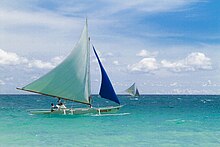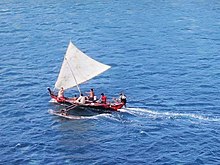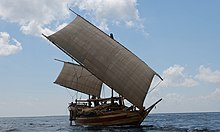
Malangbang

Malangbang or melambang is a type of medieval sailing ship from Indonesia. It is mentioned mainly in the History of Banjar. The name "malangbang" is considered to originate from the Old Javanese language, malabong (malaboṅ) which refers to a particular type of boat.[1]: 1092 [2] Malangbang is one of Majapahit's main naval vessel types after jong and kelulus.[3][4][5] Not much is known about this type of ship, apart from the fact that it also used oar beside the sails to propel it,[6][7] broad and flat-bottomed,[8] and was a "medium-sized" ship, between the size of jong and kelulus, larger and faster than pilang (pelang).[9]

Lambu Mangkurat, the king of Kuripan[10] used a malangbang named Si Prabayaksa to travel to Majapahit.[11][12] Quote from the Chronicle of Banjar:

He sailed in full state on board the yacht (original: malangbang) called Prabayaksa, availing himself of the insignia of royalty left by his father Ampu Jatmaka: two vertical streamers adorned with gold, two tasseled staves adorned with gold, four pennons decorated with gold paint, a braided streamer looking like a centipede embroidered with gold thread and twenty pikes with tufts of red feathers adorned with spangles of gold; his lances had biring blades inlaid with gold, their shafts where decorated with dark-red and gold paint, not to mention two state sunshades decorated with gold paint, two state lances shaped like frangipani buds, inlaid with gold and with their shafts banded with gold. The yacht was adorned with marquetry of gold; its sails were of the finest cloth; the clew-lines, the stays and the sheets were of silk and had tassels of pearls; the rudder was of timbaga suasa (a copper and gold alloy), the oars of iron-wood with bands of gold and the anchor gear of undamascened steel. The ships sailing behind her were also fully dressed.[13]: 294–297 [6][14]
See also
References
- ^ Zoetmulder, P. J. (1982). Old Javanese-English dictionary. The Hague: Martinus Nijhoff. ISBN 9024761786.
- ^ Rafiek 2011, p. 194.
- ^ Nugroho 2011, p. 271, 277, 290, 291.
- ^ Adam (2019). p. 128: "Setelah itu maka disuruh baginda musta'ibkan segala kelengkapan dan segala alat senjata peperangan akan mendatangi negeri Pasai itu; sekira-kira empat ratus jong yang besar-besar; dan lain daripada itu banyak lagi daripada melangbang [melambang] dan kelulus."
- ^ Hill (June 1960). "Hikayat Raja-Raja Pasai". Journal of the Malaysian Branch of the Royal Asiatic Society. 33: p. 98 and 157: "Then he directed them to make ready all the equipment and munitions of war needed for an attack on the land of Pasai – about four hundred of the largest junks, and also many barges (malangbang) and galleys." See also Nugroho (2011). p. 270 and 286, quoting Hikayat Raja-Raja Pasai, 3: 98: "Sa-telah itu, maka di-suroh baginda musta'idkan segala kelengkapan dan segala alat senjata peperangan akan mendatangi negeri Pasai itu, sa-kira-kira empat ratus jong yang besar-besar dan lain daripada itu banyak lagi daripada malangbang dan kelulus." (After that, he is tasked by His Majesty to ready all the equipment and all weapons of war to come to that country of Pasai, about four hundred large jongs and other than that much more of malangbang and kelulus.)
- ^ a b Nugroho (2011). p. 299, quoting Hikayat Banjar, 6.2: Dan malangbang itu bertatah emas, layarnya sachlat ainalbanat, tali bubutan dan tamberang dan tali klatnya mastuli, sama berumbai-umbaikan mutiara, kemudinya tembaga suasa, dayungnya hulin bertabu-tabukan emas, tali sauhnya besi malila.
- ^ Hikayat Banjar, 6.2: "And that malangbang was adorned with marquetry of gold; its sails were of the finest cloth; the clew-lines, the stays and the sheets were of silk and had tassels of pearls; the rudder was of timbaga suasa (a copper and gold alloy), the oars of iron-wood with bands of gold and the anchor gear of undamascened steel. The ships sailing behind her were also fully dressed.". See Nugroho (2011). p. 299 and Manguin (January 2001). p. 7.
- ^ Hill 1960, p. 202.
- ^ Ras (1968). p. 234, quoting Hikayat Banjar, 1.2: "Then Ampu Djatmaka sailed with the same boat following it. Kapal and pilang are not as speedy as Si Prabayaksa; the size and the length and the ornamentation [of them] does not surpass Si Prabayaksa.", also Nugroho (2011). p. 290: "Maka Ampu Djatmaka pun berlayar-layar dengan perahu yang sama mengikutkan itu. Kapal dan pilang itu tiada sama lajunya seperti Si Prabayaksa itu; besarnya dan panjangnya serta rupanya terlebih Si Prabayaksa itu."
- ^ Ras 1968, p. 30, 33.
- ^ Ras (1968), p. 292. Also Nugroho (2011). p. 273: "Suruh baiki malangbang Si Prabayaksa namanya dan itu dan gurap dan gali, galiut dan galiung, tongkang dan talamba dan lambu dan pargata. Aku hendak ke Majapahit mencari seperti mimpiku itu." (Order to repair the malangbang, Si Prabayaksa is the name, and that and gurap and gali, galliot and galleon, tongkang and talamba and lambu and frigate. I'm going to Majapahit seeking my dream.)
- ^ Manguin, Pierre-Yves. "Shipshape Societies: Boat Symbolism and Political Systems in Insular Southeast Asia". In Southeast Asia in the 9th to 14th Centuries, ed. David G. Marr and A. C. Milner. Singapore: Institute of Southeast Asian Studies, 1986.
- ^ Ras, J. J., 1968, Hikayat Bandjar. A Study in Malay Historiography. The Hague (Bibliotheca Indonesica, 1)
- ^ Ras (1968), p. 294–296: "Sudah itu maka Lambu Mangkurat bartulak, manunggang malangbang barnama si Prabayaksa sarta parhiasannya, mamakai tahta karajaan yang paninggal ayahnya Ampu Jatmaka itu: umbul-umbul dua diparmas, tatunggul dua diparmas, kakenda dua diparmas, kakenda dua diparmas, lalayu ampat bartulis air mas dan kakalabangan saparti lalipan barsulam air mas dan kumbala rajasa barkakitir amas dua puluh; tumbaknya biring bartatah amas, gagangnya sama bartulis galuga dangan air mas; dan payung bawat dua bartulis air mas, dan awinan dua kudup campaka bartatah amas, gagangnya tabu-tabu dangan dangan amas. Dan malangbang itu bartatah amas, layarnya sakhlat `ainalbanat, tali bubutan dan tamberang dan tali klatnya mastuli, sama barumbai-rumbaikan mutiara; kamudinya timbaga suasa; dayungnya hulin bartabu-tabukan amas; tali sauhnya basi malila. Dan banawa yang maikut itu masing-masing sama mamasang parhiasannya," See also the transliteration on the Malay Concordance Project.
Further reading
- Adam, Ahmat (2019). Hikayat Raja Pasai. Petaling Jaya: Strategic Information and Research Development Centre. ISBN 978-967-2464-00-6.
- Hill, A. H. (June 1960). "Hikayat Raja-Raja Pasai". Journal of the Malaysian Branch of the Royal Asiatic Society. 33: 1–215.
- Manguin, Pierre-Yves (January 2001). "Shipshape Societies: Boat Symbolism and Political Systems in Insular Southeast Asia". Techniques & Culture (35–36): 373–400. doi:10.4000/tc.301.
- Nugroho, Irawan Djoko (2011). Majapahit Peradaban Maritim. Suluh Nuswantara Bakti. ISBN 978-602-9346-00-8.
- Rafiek, M. (December 2011). "Kapal dan Perahu dalam Hikayat Raja Banjar: Kajian Semantik". Borneo Research Journal. 5: 187–200.
- Ras, Johannes Jacobus (1968). Hikajat Bandjar: A Study in Malay Historiography. The Hague: Martinus Nijhoff.
See what we do next...
OR
By submitting your email or phone number, you're giving mschf permission to send you email and/or recurring marketing texts. Data rates may apply. Text stop to cancel, help for help.
Success: You're subscribed now !






